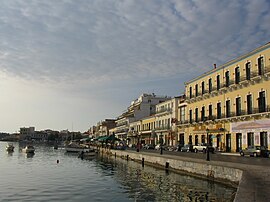Gythium
|
Gytheio Γύθειο |
|
|---|---|

The promenade
|
|
| Coordinates: 36°45.7′N 22°33.9′E / 36.7617°N 22.5650°ECoordinates: 36°45.7′N 22°33.9′E / 36.7617°N 22.5650°E | |
| Country | Greece |
| Administrative region | Peloponnese |
| Regional unit | Laconia |
| Municipality | East Mani |
| • Municipal unit | 197.3 km2 (76.2 sq mi) |
| Elevation | 5 m (16 ft) |
| Population (2011) | |
| • Municipal unit | 7,106 |
| • Municipal unit density | 36/km2 (93/sq mi) |
| Time zone | EET (UTC+2) |
| • Summer (DST) | EEST (UTC+3) |
| Postal code | 232 00 |
| Area code(s) | 27330 |
| Vehicle registration | ΑΚ |
Gytheio (Greek: Γύθειο, [ˈʝiθio]), the ancient Gythium or Gytheion (Ancient Greek: Γύθειον), is a town and a former municipality in Laconia, Peloponnese, Greece. Since the 2011 local government reform it is part of the municipality East Mani, of which it is a municipal unit. The municipal unit has an area of 197.313 km2. It was the seaport of Sparta, some 40 kilometres (25 miles) north. Gytheio used to be an important port until it was destroyed in 4th century AD, possibly by an earthquake. Today it is the largest and most important town in Mani. It is also the seat of the municipality of East Mani.
Gytheio is located in the northeastern corner of Mani and lies on the northwestern end of the Laconian Gulf. Gytheio was built on a hill called Koumaros or Laryssio in one of the most fertile areas in Mani, near the mouth of the Gythium River, which is usually dry and has been nicknamed Xerias "dry river"; today, most of the Xerias is covered by Ermou Avenue. Further northeast is the delta of the Evrotas River. Offshore are several small islands; the most important of these islands is Cranae, which is connected to the mainland by a causeway. Gytheio is only 40 km (25 mi) southeast of Sparti, connected by Greek National Road 39. The town center is situated around the port. Pine trees are situated in the west and rocky mountains in the north.
The reputed founders of ancient Gythium were Heracles and Apollo, who frequently appear on its coins or in other legends, and Castor and Pollux: the former of these names may point to the influence of Phoenician traders from Tyre, who, we know, visited the Laconian shores at a very early period. It is thought that Gytheio may have been the center of their purple dye trade because the Laconian Gulf had a plentiful source of murex. In classical times it was a community of Perioeci, politically dependent on Sparta, though doubtless with a municipal life of its own.
...
Wikipedia


